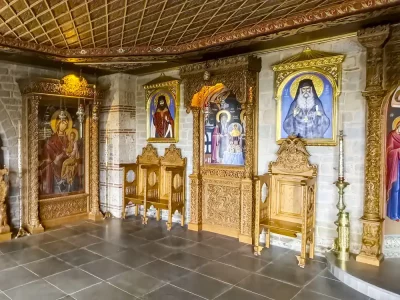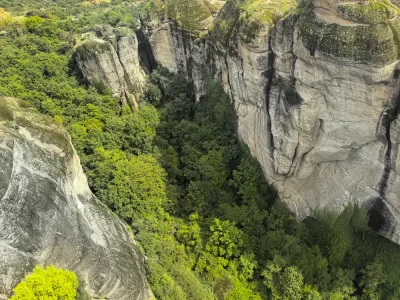Meteora is a fantastic complex of rock formations and ancient monasteries perched high on cliffs in central Greece. “Meteora” means “hanging in the air,” an apt description of these rock structures floating above the landscape. Monks seeking isolation discovered this spiritual retreat as early as the 14th century, and they began building monasteries on the roofs of the cliffs. Meteora rock monasteries.
Of the original 24, six are active today, opened to visitors. And why they weren’t. The deities have rewarded the monks in the form of modern tourism. Day after day, thousands of tourists stream in by the busloads, inoculated by the need to be here and snap the photo of a lifetime for Instagram. On the other hand, the monks have understood that the monasteries need to be charged. €3 for everyone entering, is neither too much nor too little. And they can contemplate here contentedly and live without problems until death. 🙂

Monologues about shortcuts
The audience will endure. I remember when potential superstars (singers on commercial TV) spent several hours with teacher singing before a competition. They were accompanied by a youngster on piano back then. TV promoted him as one of Slovakia’s greatest piano prodigies. He had the skills of a better ZUŠ (basic art school). I almost ran away, when the moderator of a good morning on another television presented an incredible sportsman – motorcyclist – a man who riding a motorbike climbed Stelvio Pass!!! He climb the Stelvio Pass? Really? I know people who have done it four times on a bike and don’t feel like masters of the sport.
I recently had a meeting where we discussed culture. We also discussed The Night in Venice and Gustav Mahler.
“I have the Mahler complete”, boasted a classmate (let’s call her Denise), who had recently bought a box of Golden Mahler CDs on sale at Drogerie Markt.
“And?”
“Mahler is the top. I haven’t unboxed it yet but the time will come”, Denisa reasons with empathy and insight: “I already have the Tchaikovsky and the Bach. I can do the classics…”
There was a time, a golden era, when we engaged in lively debates at goodyfairs about the nuances of music. We would passionately argue about which version, who, with whom, when and how. Our discussions would revolve around the performers, orchestras, and instruments, comparing the technical and interpretative excellence or the emotional power of the recordings. Today, it seems all one needs to do is buy a complete Golden box, and the conversation ends there. The art of discourse, it seems, has been lost in the convenience of modern consumption.
Instead of reading books, we often find ourselves scrolling through statuses and stories. Instead of reflecting, we react to headlines and profanity on the internet. Shortcuts have become the norm. But let’s not forget, everyone wants to be a farmer, but not everyone is willing to plough and plant. We all want to reap and rake, but what will be harvested if no one sows? It’s time to reflect on these societal trends, to be more thoughtful and introspective about our cultural consumption. Fortunately, I still see people around me who understand this, and it’s these individuals who inspire me to continue advocating for a more profound cultural experience.
Meteora rock monasteries



Times have changed rapidly, and many of us find ourselves overwhelmed by the desire for shortcuts. There’s little time for anything anymore. We have become collectors of achieves, wanting everything immediately and without effort. We often seek the quickest and most superficial options, neglecting the finer details of life.
So it is with tourism. You want experiences? Hundreds of ads and “musthave” attractions will jump out at you with smiling and happy faces. What do they have in common? Pay. The High Tatras are the top? Then everybody to the Tatras. Liptov? Fine. The Maldives? You must have. Unless you’ve been to Paris and live in Barcelona. If you haven’t seen Meteora…
You get on a bus that takes you to three monasteries. They drop you off in a parking lot half a kilometer from the monastery, because the road is completely blocked by dozens of other buses. They show you two perfect spots to take a selfie of the monastery, then you take a picture of your teeth with a nice background for the other ten influencers who ask you to, weave through the crowds of people and cars, pay 3 euros like thousands of other tourists do every day, get in and walk around the monastery in 20 minutes, find the restroom and get on. You will do this three times. No unnecessary stops or detours. The logistics are relentless. To keep the local restaurant on time, they have to get you to lunch on time.



The highlight of the day for many is a trip to the Panorama Restaurant, where you can purchase a magnet or a towel with the monastery’s logo and enjoy tzatziki. However, the tourist menu is often three times more expensive and twice as disappointing as what you would find in town. There aren’t many alternatives; the choices are limited. You snap a picture of your meal and post it on Instagram with a witty comment like “Lunch under Meteora,” and that’s enough to satisfy the craving for connection. ENOUGH
Meteora hiking
Organized hiking is not my preference. Crowds diminish any sense of mystique for me. I seek solitude, allowing myself to unplug and discover the real treasures of this world. It’s on trails just a few hundred yards from the main routes, where I tend to tread slowly, that I find the true essence of Meteora.
The blend of natural beauty and spiritual history in Meteora is unlike anything else. The incredible landscape features towering sandstone columns, shaped by millions of years of wind and water erosion, creating a setting that is both rugged and serene. From a distance, I can see the monasteries filled with visitors, appearing as if they are from another world, viewed from a completely different angle.
Mysticism and energy
The atmosphere outside the main Meteora route is difficult to describe. The silence that envelops this place is almost tangible, instilling a sense of calm as if one is standing among ancient secrets. Each niche and cave ignites the imagination, with many believing that these rocks possess a distinct energy. Personally, I just hope I have enough stamina to navigate the steep rocks without slipping and falling. That would hurt, especially since I’m alone here. Then, out of nowhere, a turtle appears in front of me. Not so alone, after all.
You’ll find well-marked trails that lead to breathtaking vistas. For climbers, Meteora offers ferratas of varying difficulty levels. The entire landscape is dreamlike, with every angle revealing something unique that inspires the photographer in me. While holding onto a rock with one hand, I snap pictures with the other.



Rock temples of Meteora
This unique natural wonder attracted monks as early as the 14th century, who viewed these columns as a place close to God and a source of spiritual peace. It is these remarkable rock formations that helped Meteora become one of the most significant spiritual centers of Orthodox Christianity.
Many of the icons and frescoes adorning the walls of the monasteries carry profound symbolic meanings and showcase the mysticism of Byzantine culture. Although I am not well-versed in Orthodox Christianity, the paintings in the Vaarlam monastery, which depict full barrels and vines, make it clear that even here, the monks must have experienced a whirlwind of apparitions and miracles after partaking. However, time has moved on. Today, only tourists admire the old barrels and elevators, while a powerful ceiling fan provides a refreshing breeze.



Each of the six active monasteries at Meteora has its own unique character. The Monastery of the Great Meteor is the largest, while the Monastery of the Holy Trinity gained fame from its appearance in the James Bond film “For Your Eyes Only.” Each monastery is an architectural marvel, and the frescoes, icons, and Orthodox artifacts showcase centuries of Byzantine art and culture. The entire Meteora area has been inscribed on the UNESCO World Heritage List. The views from the gardens and terraces of the monasteries are breathtaking, although navigating through the crowds of tourists taking photos can be challenging. Travel guides claim that the most beautiful views occur at sunrise or sunset when the rock formations glow with a golden light. Perhaps this is why the monasteries close to the public during these times.



Practical tips
- Proper Clothing: If you plan to visit the monasteries, it’s important to dress appropriately. Women are required to wear skirts and have covered shoulders, while men must wear long trousers. Thankfully, you can rent appropriate clothing at the entrance if needed.
- When and Where to go to Meteora: The ideal times to visit are in spring and autumn when the weather is mild and the tourist crowds are smaller. In the towns of Kalambaka and Kastraki, you will find plenty of Airbnb accommodations as well as traditional Greek tavernas offering meals at reasonable prices. The Meteora monasteries and hiking trails are conveniently close by.
- Meditation: The atmosphere at Meteora can feel similar to that of Rome’s Forum Romanum or the Sagrada Familia, with crowds often lined up and the sound of cameras detracting from the experience. Instead of joining the crowds, consider exploring Meteora on your own. You can visit the monasteries at any time, but for a more tranquil and meditative experience, you might want to wander along the nearby trails and hiking paths, which are usually much quieter.



How did Meteora come into being?
Similar to the national parks in the western United States, this region has a fascinating geological history. Over millions of years, layers of sand, mud, and rock accumulated on the seabed, hardening over time into solid sediment. As the sea receded, rivers began to erode the weaker layers of sediment, gradually revealing the more resilient layers of sandstone and granite that now form the impressive rock formations we see today. Various natural forces, mainly wind, rain, and sunlight, have shaped these rocks over thousands of years, creating their current appearance.
The monks who originally settled in this area sought spiritual solace and protection from the outside world. Historically, they used only cage lifts to reach the monasteries, secured by ropes and hooks. Life in these remote locations was challenging, and it remains difficult today. However, the experience has shifted; now, the lifts and hooks serve more as tourist attractions, while the challenges are often about navigating through crowds of visitors and dealing with congested parking areas.



This is the Meteora of today. It may feel like another world, but the crowds, the commercial activities, and the busy parking lots serve as a reminder of reality. After spending two days exploring Meteora, I returned to Thessaloniki to discover the soul of the city, Yedi Kule and its stunning beaches. Greece is truly beautiful.





